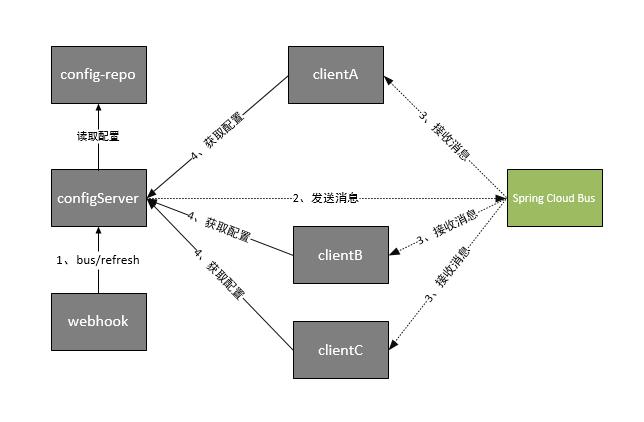本篇我们来看看怎么实现spring cloud的配置中心.
在分布式系统中,特别是微服务架构下,可能会存在许多的服务,每个服务都会存在一个或多个的配置文件.那怎么多的配置文件的管理就会成为一个大问题.同时,微服务运行过程中还需要动态的修改配置参数.所以spring cloud config就是在spring cloud微服务架构中解决配置文件的管理,刷新,查看等问题的.
注:这一个系列的开发环境版本为 java1.8, spring boot2.x, spring cloud Greenwich.SR2, IDE为 Intelli IDEA
spring cloud config和git
我们先来一个简单的配置,只有server和config的.
添加配置文件
创建一个目录,目录下分别添加3个不同的配置文件
1
2
3
|
neo-config-dev.properties
neo-config-pro.properties
neo-config-test.properties
|
里面的配置分别为neo.hello=hello in dev/pro/test
并将目录保存到gitlee/github上.
这里我的地址是 https://gitlee.com/xingyys/config-repo
server 端
接下来开始配置server
pom
1
2
3
4
5
6
7
8
9
10
11
12
13
14
15
16
17
18
19
20
21
22
23
24
25
26
27
28
29
|
<properties>
<java.version>1.8</java.version>
<spring-cloud.version>Greenwich.SR2</spring-cloud.version>
</properties>
<dependencies>
<dependency>
<groupId>org.springframework.cloud</groupId>
<artifactId>spring-cloud-config-server</artifactId>
</dependency>
<dependency>
<groupId>org.springframework.boot</groupId>
<artifactId>spring-boot-starter-test</artifactId>
<scope>test</scope>
</dependency>
</dependencies>
<dependencyManagement>
<dependencies>
<dependency>
<groupId>org.springframework.cloud</groupId>
<artifactId>spring-cloud-dependencies</artifactId>
<version>${spring-cloud.version}</version>
<type>pom</type>
<scope>import</scope>
</dependency>
</dependencies>
</dependencyManagement>
|
配置文件
1
2
3
4
5
6
7
8
9
10
11
12
13
14
15
16
|
server:
port: 8001
spring:
application:
name: config-server
cloud:
config:
server:
git:
uri: https://gitee.com/xingyys/config-repo
# 配置文件保存的目录,用,分隔
search-paths: config-repo
username: username
password: password
# 忽略ssl, 或者自行配置秘钥
skip-ssl-validation: true
|
Spring Cloud Config也提供本地存储配置的方式。我们只需要设置属性spring.profiles.active=native,Config Server会默认从应用的src/main/resource目录下检索配置文件。也可以通过spring.cloud.config.server.native.searchLocations=file:E:/properties/属性来指定配置文件的位置。虽然Spring Cloud Config提供了这样的功能,但是为了支持更好的管理内容和版本控制的功能,还是推荐使用git的方式。
启动类
添加注解@EnableConfigServer,启动配置中心服务端功能
1
2
3
4
5
6
7
8
9
|
@SpringBootApplication
@EnableConfigServer
public class ConfigServerApplication {
public static void main(String[] args) {
SpringApplication.run(ConfigServerApplication.class, args);
}
}
|
测试
直接编译打包就可以测试了,直接访问http://localhost:8001/neo-config/dev返回:
1
2
3
4
5
6
7
8
9
10
11
12
13
14
15
16
17
|
{
"name": "neo-config",
"profiles": [
"dev"
],
"label": null,
"version": null,
"state": null,
"propertySources": [
{
"name": "https://gitee.com/xingyys/config-repo/config-repo/neo-config-dev.properties",
"source": {
"neo.hello": "hello im dev"
}
}
]
}
|
上述的返回的信息包含了配置文件的位置、版本、配置文件的名称以及配置文件中的具体内容,说明server端已经成功获取了git仓库的配置信息。
仓库中的配置文件会被转换成web接口,访问可以参照以下的规则:
- /{application}/{profile}[/{label}]
- /{application}-{profile}.yml
- /{label}/{application}-{profile}.yml
- /{application}-{profile}.properties
- /{label}/{application}-{profile}.properties
以neo-config-dev.properties为例子,它的application是neo-config,profile是dev。client会根据填写的参数来选择读取对应的配置。
client 端
用来获取server端上的配置信息
pom
1
2
3
4
5
6
7
8
9
10
11
12
13
14
15
16
17
18
19
20
21
22
23
24
25
26
27
28
29
30
31
32
33
34
|
<properties>
<java.version>1.8</java.version>
<spring-cloud.version>Greenwich.SR2</spring-cloud.version>
</properties>
<dependencies>
<dependency>
<groupId>org.springframework.cloud</groupId>
<artifactId>spring-cloud-starter-config</artifactId>
</dependency>
<dependency>
<groupId>org.springframework.boot</groupId>
<artifactId>spring-boot-starter-web</artifactId>
</dependency>
<dependency>
<groupId>org.springframework.boot</groupId>
<artifactId>spring-boot-starter-test</artifactId>
<scope>test</scope>
</dependency>
</dependencies>
<dependencyManagement>
<dependencies>
<dependency>
<groupId>org.springframework.cloud</groupId>
<artifactId>spring-cloud-dependencies</artifactId>
<version>${spring-cloud.version}</version>
<type>pom</type>
<scope>import</scope>
</dependency>
</dependencies>
</dependencyManagement>
|
配置文件
config client的配置文件为 bootstrap.properties
1
2
3
4
5
6
7
|
spring.cloud.config.name=neo-config
spring.cloud.config.profile=dev
spring.cloud.config.uri=http://localhost:8001/
spring.cloud.config.label=master
spring.application.name=config-client
server.port=8002
|
- spring.application.name:对应{application}部分
- spring.cloud.config.profile:对应{profile}部分
- spring.cloud.config.label:对应git的分支。如果配置中心使用的是本地存储,则该参数无用
- spring.cloud.config.uri:配置中心的具体地址
- spring.cloud.config.discovery.service-id:指定配置中心的service-id,便于扩展为高可用配置集群。
这些与spring-cloud相关的属性必须配置在bootstrap.properties中,config部分内容才能被正确加载。因为config的相关配置会先于application.properties,而bootstrap.properties的加载也是先于application.properties。
启动类
1
2
3
4
5
6
7
8
|
@SpringBootApplication
public class ConfigClientApplication {
public static void main(String[] args) {
SpringApplication.run(ConfigClientApplication.class, args);
}
}
|
接口类
1
2
3
4
5
6
7
8
9
10
|
@RestController
public class HelloController {
@Value("${neo.hello}")
private String hello;
@RequestMapping("/hello")
public String from() {
return this.hello;
}
}
|
测试
编译启动config client, 访问http://192.168.1.13:8002/hello返回: hello im dev 配置成功!
配置中心
前面我们已经配置config server和config client,而且也已经可以使用了,但是它还只能单独使用,接下来我们需要对它们进行一些改造,用在微服务架构中.
注册中心
这里的注册中心直接使用前几篇留下的就可以.
server 端的改造
添加依赖
1
2
3
4
5
6
|
...
<dependency>
<groupId>org.springframework.cloud</groupId>
<artifactId>spring-cloud-starter-netflix-eureka-server</artifactId>
</dependency>
...
|
修改配置文件
1
2
3
4
5
6
|
...
eureka:
client:
service-url:
defaultZone: http://localhost:8000/eureka/
...
|
启动类
添加注解@EnableDiscoveryClient:
1
2
3
4
5
6
7
8
9
10
|
@SpringBootApplication
@EnableConfigServer
@EnableDiscoveryClient
public class ConfigServerApplication {
public static void main(String[] args) {
SpringApplication.run(ConfigServerApplication.class, args);
}
}
|
记得重新编译,启动
client 端的改造
添加依赖
1
2
3
4
5
6
|
...
<dependency>
<groupId>org.springframework.cloud</groupId>
<artifactId>spring-cloud-starter-netflix-eureka-server</artifactId>
</dependency>
...
|
修改配置文件
同样是 bootstrap.properties
1
2
3
4
5
6
7
8
9
10
|
spring.cloud.config.name=neo-config
spring.cloud.config.profile=dev
spring.cloud.config.label=master
spring.cloud.config.discovery.enabled=true
spring.cloud.config.discovery.serviceId=config-server
eureka.client.serviceUrl.defaultZone=http://localhost:8000/eureka/
spring.application.name=config-client
server.port=8002
|
主要是去掉了spring.cloud.config.uri直接指向server端地址的配置,增加了最后的三个配置:
- spring.cloud.config.discovery.enabled :开启Config服务发现支持
- spring.cloud.config.discovery.serviceId :指定server端的name,也就是server端spring.application.name的值
- eureka.client.serviceUrl.defaultZone :指向注册中心的地址
启动类
1
2
3
4
5
6
7
8
9
|
@SpringBootApplication
@EnableDiscoveryClient
public class ConfigClientApplication {
public static void main(String[] args) {
SpringApplication.run(ConfigClientApplication.class, args);
}
}
|
测试
一次启动 discovery, config-server和config-client, 访问http://127.0.0.1:8000/

访问http://localhost8002/hello, 返回hello im dev .
结合消息总线
其实上面的配置还有一个问题,就是配置文件更新后,config client不能同步更新,需要重启.针对这个问题,已经有一些的解决方法了,一种是配置 gitlee或github的webhook,另一种就是使用消息总线.我们就来尝试后者.
spring cloud中可以和rabbitmq结合实现.
安装rabbitmq
rabbitmq的安装教程网上有很多,这里为了简单,我们就直接使用docker来安装.
这里我准备了一个虚拟机192.168.1.10, 上面安装了docker
1
2
3
4
|
# 拉取rabbitmq镜像
docker pull rabbitmq:management
# 启动镜像
docker run -d -p 5672:5672 -p 15672:15672 --name rabbitmq rabbitmq:management
|
执行成功后登录rabbitmq, http://192.168.1.10/15672, 用户名/密码为 guest/guest.
client 端的改造
接下来就是修改client端了
添加依赖
1
2
3
4
5
6
|
...
<dependency>
<groupId>org.springframework.cloud</groupId>
<artifactId>spring-cloud-starter-bus-amqp</artifactId>
</dependency>
...
|
配置文件
1
2
3
4
5
6
7
8
9
10
11
12
|
...
## 添加配置刷新的接口url
management.endpoints.web.exposure.include=bus-refresh
## 开启消息跟踪
spring.cloud.bus.trace.enabled=true
spring.rabbitmq.host=192.168.1.10
## rabbitmq登录使用5672, 15672是web端口,别搞错了!
spring.rabbitmq.port=5672
spring.rabbitmq.username=guest
spring.rabbitmq.password=guest
|
接口
修改接口HelloController, 添加注解@RefreshScope
1
2
3
4
5
6
7
8
9
10
11
|
@RestController
@RefreshScope
public class HelloController {
@Value("${neo.hello}")
private String hello;
@RequestMapping("/hello")
public String from() {
return this.hello;
}
}
|
测试
修改配置文件,使用命令curl -X POST http://localhost:8002/actuator/bus-refresh更新,在访问http://localhost:8002/hello
如果返回500错误,请检查rabbitmq连接
改进 server
上面的配置只是针对单个client的,如果要让所有的client都更新,就需要使用curl对每个client操作.所有我们将修改server, 当配置文件修改后,刷新server时,同时刷新所有的client.

添加依赖
1
2
3
4
|
<dependency>
<groupId>org.springframework.cloud</groupId>
<artifactId>spring-cloud-starter-bus-amqp</artifactId>
</dependency>
|
配置文件
1
2
3
4
5
6
7
8
9
10
11
12
13
14
15
16
17
18
19
20
21
22
23
24
25
26
27
28
29
30
31
32
33
34
|
server:
port: 8001
spring:
application:
name: config-server
cloud:
config:
server:
git:
uri: https://gitee.com/xingyys/config-repo
search-paths: config-repo
username: username
password: password
skip-ssl-validation: true
bus:
trace:
enabled: true
rabbitmq:
host: 192.168.1.10
port: 5672
username: guest
password: guest
management:
endpoints:
web:
exposure:
include: bus-refresh
eureka:
client:
service-url:
defaultZone: http://localhost:8000/eureka/
|
测试
修改配置文件,执行命令 curl -X POST http://localhost:8001/actuator/bus-refresh.

